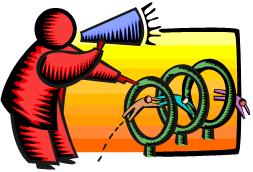Resolving Conflict Successfully
By Ellen and Dana Borowka, MA, Excerpt from the book, Cracking the Business Code
Ever notice that no matter what you do, you can’t avoid conflict! It’s everywhere – at work, at home, at that special social gathering or even at the supermarket. Whether you are discussing the dirty dishes with your spouse, that difficult project with a co-worker, or your barking dog with the  next door neighbor – conflict is hard to manage well. And since we can’t ignore it, we might as well handle it the best possible way. In this article, we’re going to explore what makes up conflict, how we usually (and unsuccessfully) handle it, and ways to manage it better.
next door neighbor – conflict is hard to manage well. And since we can’t ignore it, we might as well handle it the best possible way. In this article, we’re going to explore what makes up conflict, how we usually (and unsuccessfully) handle it, and ways to manage it better.
Conflict vs. Resolution
First, I’d like to define what conflict is, so we know what we are working with. The first definition is war; and the second is a clash between hostile or opposing ideas, interests or persons. War! That’s a big word! Some might think that their conflicts don’t rate up with war. Yet, just because we don’t pull out guns and bombs, doesn’t mean that we don’t have some casualties in our battles. Many people can go for the kill when they feel hurt and angry, especially in our intimate relationships. Other definitions include, an earnest struggle for superiority or victory; and the state of those who disagree and lack harmony. How many times in conflict do we struggle to be superior to, and have victory over the another, especially when they are acting rude? I think the key phase for conflict is that we lack harmony, and that is not a fun place to be at.
So, what is our alternative? Conflict resolution! It’s a way to settle disagreements peacefully by getting to the root of problems and finding lasting solutions. Why is conflict resolution so important? Knowing how to handle conflict in a constructive manner can help you in relating with others, like your spouse, children and co-workers. Conflict resolution assists by promoting new ideas, encouraging greater understanding, strengthening personal relationships and keeping people safe from violent conflict escalating out of control. It helps us to work through our issues to find harmony and unity with others.
The Three Components of Conflict
What do you need to have conflict erupt? It takes very little to create conflict. In fact, you need only three components to have conflict flare up. As they say in commercials, “It’s as easy as 1,2,3!” The first is people. Conflict can occur between individuals, between groups or among members of the same group. Anywhere where you have people, you can have conflict. The second is different points of view. When each person or group sees a situation in a different way, wants a different outcome or has different plans of what to do then you can have conflict. An example that comes to my mind is the family reunion where conflict can start easily, even over where to go for dinner. The third component is strong emotions. Individuals or groups may have strong feelings about the problem or situation. They may feel a variety of emotions, like anger, fear, disappointment, betrayal, hurt, and so on. Strong feelings can set the stage for a potential war.
Mapping Out Conflict
Yet, conflict is a normal part of life. As I said before, wherever we go we might run into it – misunderstandings with a co-worker, dealing with a difficult client, or a changing relationship with a spouse or friend. So, what can we do about it? Something that seems to be very helpful is an exercise called the Relationship Web, which maps out the status of your relationships. Drawing a relationship web is very easy. First, on a piece of regular size paper, draw a circle in the middle and put your name in it. Then draw other circles around yours and put names of those people that have an impact on your life. You then connect your circle to each of your other circles with a variety of lines. A straight line signifies a peaceful and calm relationship; a slightly wavy line is a relationship that has occasional ups and down; a very wavy line denotes a relationship with many ups and downs; and a jagged line is a stormy relationship. The lines of your web might look like spokes on a wheel that attach to your center circle. When you are done with your web, you might want to consider the following questions for your relationships: Why do you think you have conflict with this person? And if you could change some of these wavy and jagged lines, which ones would you change and why? Now that you have explored the conflict in your relationships, it might be helpful to look how you handle conflict.
Common Conflict Styles
The following are some ways that we commonly deal with conflict:
- Avoid or runaway from the conflict. An example of this could be when someone refuses to address a problem with a spouse or co-worker.

- Pretend the conflict doesn’t exist. This is when we deny that there is even a problem to address!
- Give in or go along with the other person. When we give in or go along, we deny our own needs and build resentment towards the other person.
- Attack or try to win through force or power with criticism, insults, manipulation, name-calling or violence, which is a very destructive method to deal with conflict.
As you might imagine, none of these styles resolve our problems. Rather, they worsen the situation – allowing conflict to fester and explode out of control. So, how do you handle conflict? Do you have a conflict style that you use in difficult situations? Let’s look at some ways that we can deal with conflict in a healthier manner. Since good communication is the key to successful conflict resolution, we’ll start there.
Elements of Successful Communication
- Have respect for the other person’s feelings and point of view, even though you don’t agree. The goal to successful communication is to have empathy – to understand why someone is doing what they are doing and feeling what they are feeling. We feel that empathy is the glue in all relationships. If you don’t have empathy, you don’t have anything.
- Don’t take the conflict personally, don’t let it under your skin. Let the other person blow off steam, and be patient. Many people say things in anger that they don’t mean.
- Be a good listener! To be a good listener, you need to avoid interrupting the other person, and ask questions when they are finished speaking. Also, watch body language to be aware of what is going on with the other person, and to look for mixed messages. Mixed messages are when someone says one thing, yet their body language is saying the opposite. There is an old saying, “The most important thing in communication is to hear what isn’t being said.” – Unknown
- State what you’re hearing. Use active listening, which is to paraphase what you think the other person is saying. This tells them that you understand what they are saying, and gives them the chance to explain, if you didn’t understand. This is an extremely effective tool in managing conflict and avoiding miscommunication.
- Use “I Statements” when discussing hot subjects. An example of an I statement is “I feel really hurt when you snap at me, because it makes me feel like you don’t respect me.” An I statement is composed of three elements. The “I” helps us to maintain our responsibility for our feelings or observations; the “when” gives a specific example for the other person; and the “because” provides our reason for why we are bothered by the situation. I statements helps us to avoid being vague and accusatory with others.
- State your feelings clearly – express what you think without attacking the other person. Don’t be hostile or use name-calling, criticism or insults – that will only make things worse.
- Focus on the problem, not the person. Look for common ground – a shared need – something you both want or can agree on. This will strengthen teamwork between the both of you.
- Are there any hidden agendas? Is there something that is bothering the other person that he or she is not talking about, that might be feeding into the problem. Asking questions is a good way to uncover hidden agendas, like: Is something else bothering you? Is there something else going on? You look like you have something more to say?
- Take timeouts to keep conflict from escalating. When things get too hot, take some time to cool down – at least an hour or 24 hours. Be sure to schedule a follow-up time to resolve the issue.
The Problem Solving Process
After you have had a full discussion about the conflict then you may want to brainstorm with the other person to find some ways to resolve the problem. First, set an agenda on  what you both want to focus on in the situation. Next, brainstorm for different ideas to solve the problem. One of you should write down the ideas, and don’t evaluate the ideas during the brainstorming process. Sort through the ideas and implement a specific action plan. Consider every idea and think about the consequences. Then arrange a follow-up date to check in on the progress of the action plan. If the plan is not working then recycle through the problem solving process again.
what you both want to focus on in the situation. Next, brainstorm for different ideas to solve the problem. One of you should write down the ideas, and don’t evaluate the ideas during the brainstorming process. Sort through the ideas and implement a specific action plan. Consider every idea and think about the consequences. Then arrange a follow-up date to check in on the progress of the action plan. If the plan is not working then recycle through the problem solving process again.
Successful Conflict Resolution Takes Practice!
These are some tips to manage conflict in a structured and positive format. It takes practice – so don’t throw it out, just because it takes some extra effort. Conflict resolution is not, by any means, the easiest thing to do. Yet, when we don’t deal with our conflicts, they fester and grow worse. It’s like when we feel sick and throw up. Noone likes it, but it cleans out the system and we feel much better. Successful conflict resolution takes practice, patience and respect. There’s an old saying, “Coming together is a beginning, Keeping together is progress, Working together is Success!” How you handle conflict will determine its outcome!
Permission is needed from Lighthouse Consulting Services, LLC to reproduce any portion provided in this article. © 2016
Dana Borowka, MA, CEO and Ellen Borowka, MA, Senior Analyst of Lighthouse Consulting Services, LLC with their organization constantly remain focused on their mission statement – “To bring effective insight to your organization”. They do this through the use of in-depth work style assessments to raise the hiring bar so companies select the right people to reduce hiring and management errors. They also have a full service consulting division that provides domestic and international interpersonal coaching, executive onboarding, leadership training, global options for expanding your business, sales and customer service training, operational productivity improvement, 360s and employee surveys as well as a variety of workshops. They have over 25 years of business and human behavioral consulting experience. They are nationally renowned speakers and radio personalities on this topic. They are the authors of the books, “Cracking the Personality Code” and “Cracking the Business Code”. To order the books, please visit www.lighthouseconsulting.com.
If you would like additional information on this topic or others, please contact your Human Resources department or Lighthouse Consulting Services LLC, 3130 Wilshire Blvd., Suite 550, Santa Monica, CA 90403, (310) 453-6556, dana@lighthouseconsulting.com & our website: www.lighthouseconsulting.com.
Lighthouse Consulting Services, LLC provides a variety of services, including in-depth work style assessments for new hires & staff development, team building, interpersonal & communication training, career guidance & transition, conflict management, 360s, workshops, and executive & employee coaching. Other areas of expertise: Executive on boarding for success, leadership training for the 21st century, exploring global options for expanding your business, sales and customer service training and operational productivity improvement.
We recently launched a new service called Sino-Am Leadership to help executives excel when stationed outside their home country. American managers in Asia and Asian managers in America face considerable business, personal, and leadership challenges because of the cultural differences. This unique program provides personal, one-on-one coaching. For more information visit, https://lighthouseconsulting.com/performance-management/talent-development/sino-american-management-style/.










